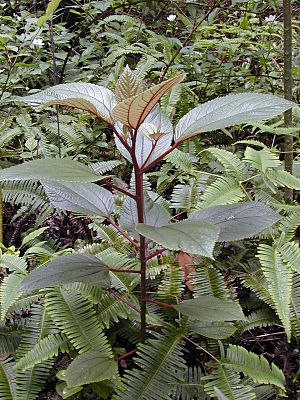Waimea pipturus facts for kids
Quick facts for kids Māmaki |
|
|---|---|
 |
|
| Scientific classification | |
| Genus: |
Pipturus
|
| Species: |
albidus
|
Māmaki (scientific name: Pipturus albidus) is a special plant that grows only in Hawaiʻi. It's sometimes called waimea or Waimea pipturus. This plant is part of the nettle family, Urticaceae, but it doesn't sting like some other nettles you might know!
Māmaki is a small tree. It can grow up to 9 meters (about 30 feet) tall, which is like a three-story building! Its trunk can be about 0.3 meters (1 foot) wide. You can find māmaki trees in different kinds of forests across Hawaii. They grow from areas near the coast to wet rainforests high up in the mountains, from about 60 meters (200 feet) to 1,830 meters (6,000 feet) above sea level.
What is Māmaki Used For?
Traditional Medicine
Long ago, Native Hawaiians used the māmaki fruit to make special medicines. These medicines helped with certain illnesses. They also made a healthy herbal tea from fresh māmaki leaves, hot stones, and spring water. This tea was good for helping people feel stronger when they were tired or weak. Today, you can even buy packages of dried māmaki leaves to make your own tea!
Other Uses
Native Hawaiians also used the strong inner fibers of the māmaki plant. They used these fibers to make kapa (a type of bark cloth) and kaula (rope).
Māmaki in Nature
The māmaki plant is very important for some animals in Hawaii. It is the favorite food plant for the caterpillars of the Kamehameha butterfly (Vanessa tameamea). These caterpillars eat the māmaki leaves as they grow. Sometimes, the caterpillars of the green Hawaiian blue butterfly (Udara blackburni) also eat māmaki leaves.
Images for kids


